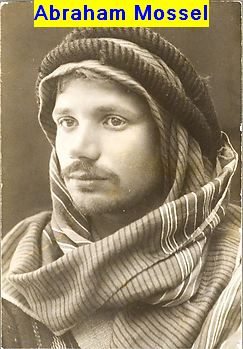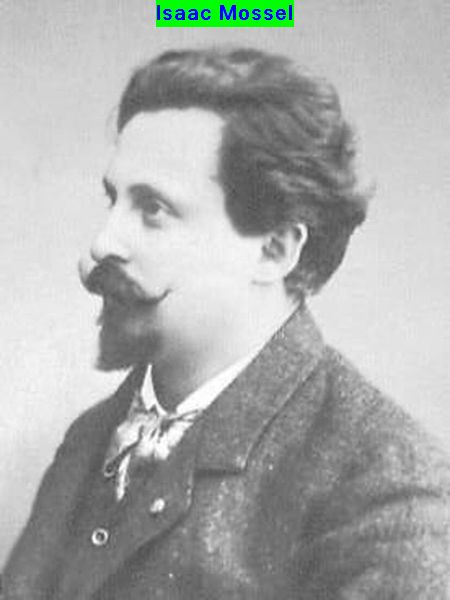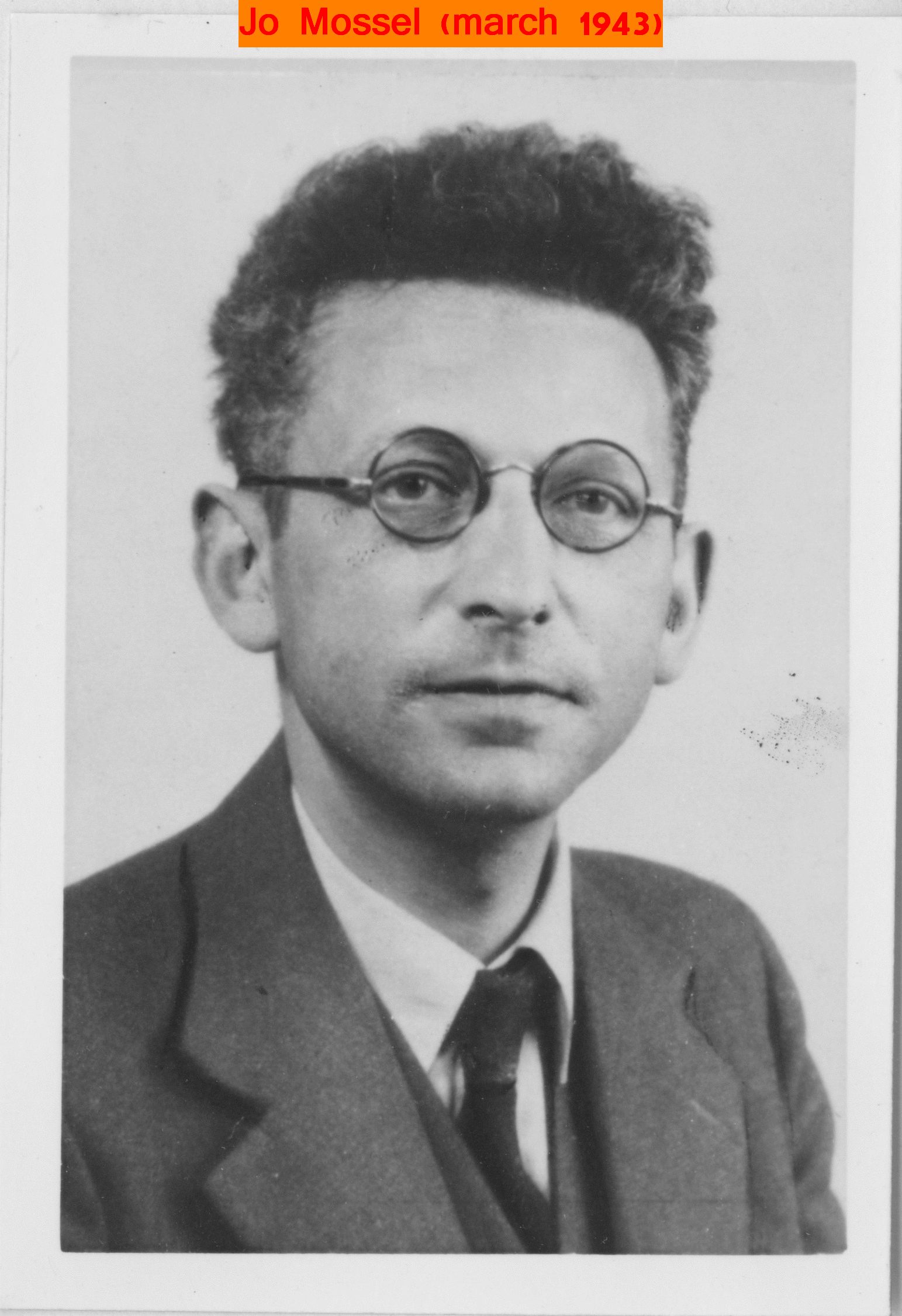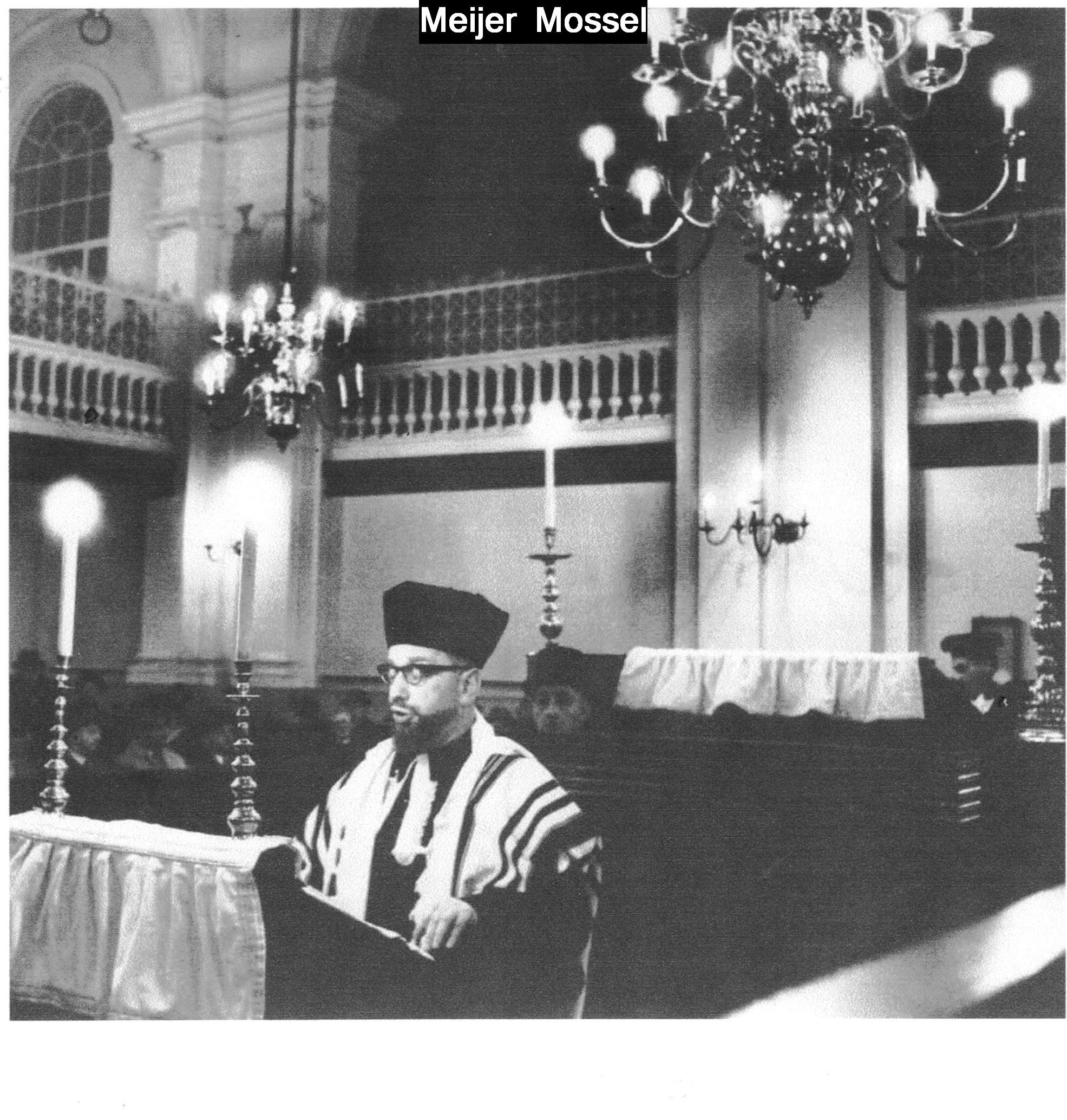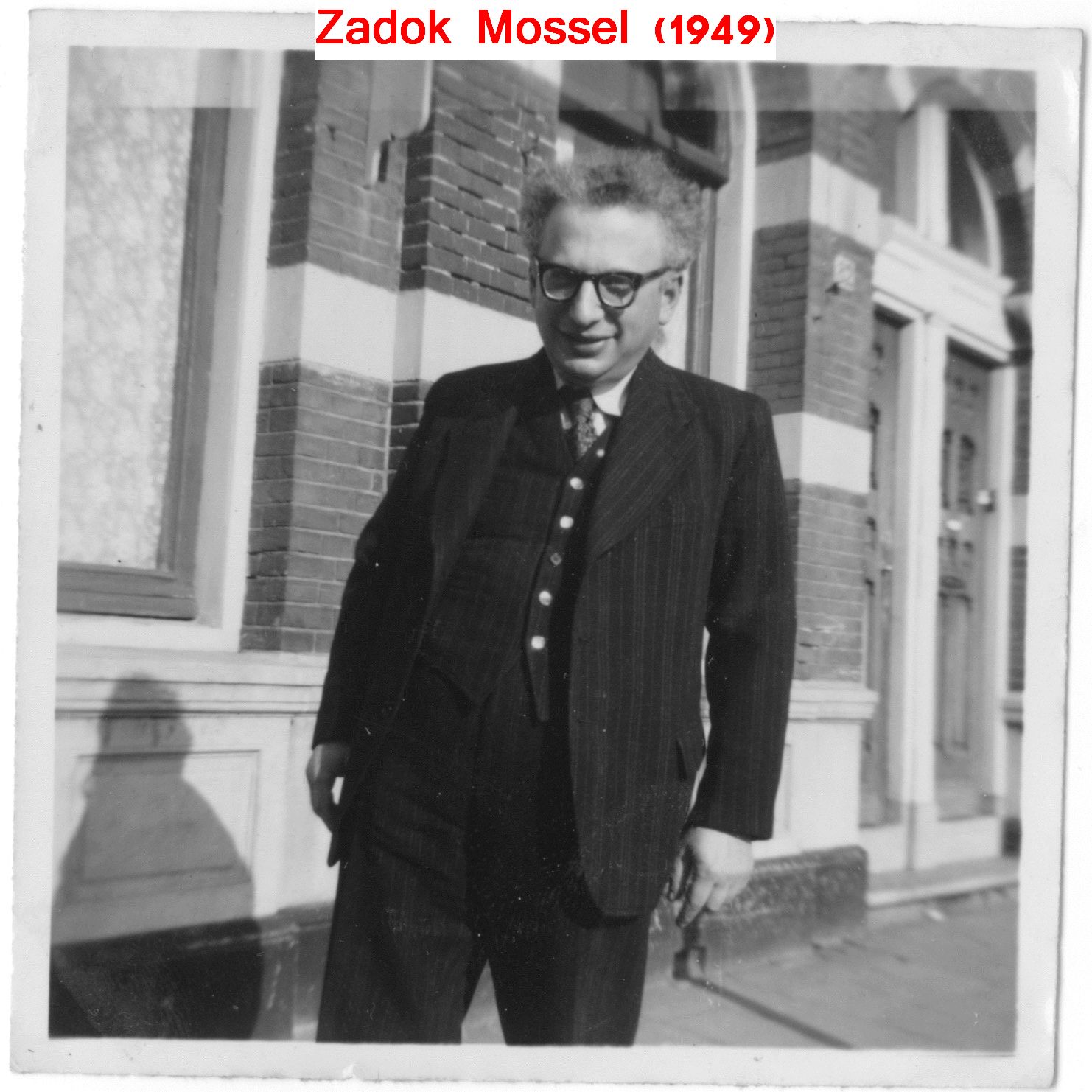The Mossels from Mokum
Source:
"The Mossels from Mokum," a 350 years stay in one city",
Esther D. Reiss-Mossel , Moshe Mossel, Leontine Veerman.
Introduction
One of the reasons for writing this book is that Jo Mossel, the father of Esther Reiss-Mossel, has never been mentioned by any Jewish authority, notwithstanding the fact that he was an outstanding person.
The only place where he is still remembered is the former high school in Alkmaar where he was a mathematics teacher.There he appears in the lustrum books, his portrait is in the corridor and on the 5th of May, Liberation Day, the Jewish math teacher, whose career was forever cut off by the Germans, is being remembered.
In 1933 Jo Mossel and his wife Els founded a branch of the Zionist movement in Alkmaar. Jo held a speech on antisemitism and its consequences. From 1933 till 1937 he was the editor of the "Joodsche Wachter", where he published literary criticism and articles on Jewish holidays. His favorites were the poems of Bialik, some of which he translated into Dutch. He also was the chairman of the Jewish Youth Federation and the compiler of the highest grade of Hebrew examinations, which were not easy at all.
His brother, Zadok Mossel, was also one of the prominent Dutch Zionists at the time. Many "olim" going to Palestine,were taught Hebrew by him. He also published a column "Jom Jom" in Zionist weeklies. Zadok Mossel is not mentioned anywhere, either !
Another relative, Abraham Mossel, also remained almost unknown. He wrote three books, “The World Hikers. A Hike through Europe” (1917), "As a day laborer in the Holy Land",(1918), describing the life of laborers in the Jewish settlements of Palestine, during the Turkish regime - about the years 1913-1914, and a third book, unpublished owing to the World Crisis, about a bicycle trip to Spain and Marokko with his friend Hendrien Schweiger (1925).
"The Mossels from Mokum," intends to save an honorable place for the members of the Mossel family, who never received recognition for their Zionist and other activities.
Preface
David Ben Gurion encouraged people to adopt Hebrew names. One member of the Mossel family firmly refused to do so. In this article we shall return to the origin of this name.
Mossel families lived in Amsterdam for more than 350 years. Amongst the ancestors were butchers, printers, diamond workers, cantors and teachers. Much information about the Mossel family was unearthed by genealogical research done by Moshe Mossel, in Dutch and Hebrew documents. Usually these were engagement or marriage acts, documents detailing the dowry and sometimes a "haliza" confirmation – an exemption of marriage with a widowed sister-in-law.
The "first" Mossels
Some ancestors of the Mossel family were members of the Loeza family, which according to tradition were Sephardim, hailing from Italy. This tradition may be true, because several family members had a darker skin color. Official documents however, point to Koblenz and surroundings, without any mention of Italian roots.
At the start of the 20th century, both families, the Loeza's as well as the Mossels, were part of the Jewish proletariat of Amsterdam.
The marriage of Jo Mossel and that of his brother Zadok, went against family tradition, because both of them married girls which were not rooted in Amsterdam. Else Buchenbacher, married (to) Jo Mossel, as well as Anna Libourkin, who married Zadok Mossel were both born in Amsterdam, but came from immigrant families.
Usually family members of the bride and groom were from Amsterdam. Many marriages were contracted within the family. Cousins married nieces, uncles and even great-uncles married nieces and widowers married sisters of their late spouse. This was a widespread Jewish custom, for which official civil permission had to be obtained.
According to documents from the year 1729, the first male ancestor of the family-branch, Elias ben Joseph, settled in Amsterdam before 1700, arriving from Büttelborn in Hessen-Darmstadt. Elias married Ester, the daughter of Moshe Mossel. This marriage, like other marriages from the same period, was not officially registered.
The name Mossel is derived from Moshe or Moishele, and from 1770 onwards it became the family name.
Moshe-Mossel, Ester's father, must have been an important person, probably identical with Mossel ben Hirsch Shohet, whose father was one of the first "shochatim" of the Jewish community in Amsterdam. This Hirsch Shochet is probably the same person as Hartog Samuel from Hessenland, a widower who married Hendele Jacob in 1657.
He published a book in Amsterdam, titled Avkath Rochel with the printing house of Menashe ben Israel, written in Yiddish, giving good advice for the daily life.
He died in 1681 as Naftalie Samuel Pappenheim and was buried in Muiderberg. His son Mossel, Ester's father, died in 1712. After his death Ester had a youngest son, who was called after the grandfather. The Portuguese Jews used to call children also after living grandparents, the Ashkenazi Jews however did so only after the decease of the grandparent. Afterwards this custom was changed, which probably was a sign of their assimilation to their new surroundings.
Two sons of Elia ben Joseph Batelbaren (Bütelborn) married about 1730 with two sisters Tamar and Mindele Pelts. They were the direct ancestors (of the) of the Mossel family branch discussed here.
Some of the Jewish marriage acts have been saved. The engagement however, was usually announced by the so called 'puyboeken' of the town of Amsterdam. The betrothal announcement was glued to the façade (pui-in old Dutch) of the town hall of Amsterdam. The puyboeken stated the private and family names of the couple, the proclamation of the betrothal date, the occupation, the address and place of birth of the couple and the names of the two witnesses, usually the father and the mother, or any other family member of the couple.
The announcement with the civil authority was obligatory. The churches however were autonomous regarding the conclusion of the marriage. The rabbinical document, the "ketuba," was signed during the marriage ceremony.
With regard to Alexander Mossel no rabbinical documents were found, only civil ones. We know that he was married to the sister of his brother's Jacob wife.
At the start of the 20th century the Mossel brothers all bore traditional names of the family. So Jo Mossel was called after his grandfather from mother's side, Joseph Loeza. Zadok was called after his living grandfather Zadok Mossel, Jacques after the eldest brother of this grandfather. The rules of giving these names were kind of obligatory. The eldest child received the name of the grandfather or grandmother from father's side, the second child received the name of the grandfather or grandmother from mother's side. The other children received the names of brothers or sisters of the parents.
The marriage between Zadok Mossel and Betje van Wageningen, a daughter of Arie van Wageningen, soldier of the Dutch army in the secession war with Belgium. For his participation he obtained the Military Willemsorde IV-th class.
Zadok Mossel, the grandfather of the five brothers, was the youngest one of a family of eleven children. His oldest sister Anna was born 25 years before him.
The list of poor people from 1809 shows many ancestors of the Mossel family. It includes Aron Jacob Mossel, the father of Mozes and the grandfather of Zadok, who passed away in 1814, registered as Jacob Sander Mossel.
The same list registers two widows with the similar name of Fraadche. They were the widows of Salomon and Elia Mossel respectively.
A grandson of Salomon Mossel married Jetje Samehtini in Middelburg in 1849. They had a son Hendrik Mossel and a grandson Isaac Mossel, born in 1871, who became a famous cellist, who played in the Concertgebouw Orchestra of Amsterdam. Other descendants of this family settled in places like Medemblik, Edam and Hoorn.
In the 19th century Mossel and Loeza family members lived in Vlooyenburg, a very poor quarter of Amsterdam, inhabited mainly by Jews.
The family of Mozes Mossel
In 1895 Mozes Mossel (Amsterdam 1872–Auschwitz 1943) married Heintje Loeza (1872-1928). The ancestor of Mozes - Aron Jacob Mossel (1749-1814) married Annaatje Slagter (1751-1797) in 1774. Their son Mozes Mossel (1788-1860) married Claartje Glasslijper (1794-1896) and one of their sons, Zadok (1842-1905) was the [great-grand]father of Mozes Mossel.
Zadok Mossel was one of the lucky ones who found work in the diamond industry.
This profession was divided into several "classes". The splitters split the diamonds, than the cutters cut the sharp corners and after them came the grinders who shaped the facets, which gave the diamond its shine.
The diamond workers were organized in several organizations. The main one was the socialistic ANDB, the Algemene Nederlandse Diamantbewerkers Bond. Later on other labor unions with a religious background were founded; a Protestant, a Roman Catholic and in 1895 a Jewish union, called "Betsalel." It is quite possible that Zadok Mossel was a member of Betsalel, because the Mossels were religious.
Mozes Mossel and Heintje Loeza had eight children. Two of them died after birth. Mozes Mossel supported his family well and in time their living conditions even improved. His wife Heintje died in 1928, after a prolonged illness. On the eve of the Second World War grandfather Mozes Mossel lived with his son Meijer in the Nieuwe Kerkstraat in Amsterdam.
The five sons of Mozes, Joseph (1897), Zadok (1899), Jacques (1902) Aaron (1908) and Meijer (1910) were all intelligent boys. Some of them served as religion teachers and cantors. Joseph (Jo) the the eldest studied mathematics and biology. Jo and Aron Mossel, a diamond worker as well as a professional card player were not religious in adult life.
The eldest Joseph (Jo) Mossel, finished the Stedelijk Gymnasium at the Weteringschans in Amsterdam. It is not clear if and when he passed the final examinations, which was not an easy matter for a poor and religious Jew. Possibly he studied at home for his final exam, and he finished the Gymnasium in five years and not the customary six years. At the university he became a member of the Zionist Student Organization.
For many years he taught mathematics and biology at the high school in Alkmaar and was also active in the small Jewish community there.
In the summer holidays of 1937 he went to Palestine with his wife Else Buchenbacher.
For several years he was the editor of "De Joodse Wachter." He was a member of the "General Zionists," a political party, which demanded a complete settlement of Jewish rights in Palestine, before massive immigration should be started.
Zionism in the Netherlands started very slowly. The life of the Dutch Jews was never threatened, which was one of the reasons that in the twenty years between 1920 and 1940 only 1200 people migrated to Palestine.
Jo and Else built a house in Heiloo. They had three children: Benjamin Mozes, Henriette and Esther Debora. It was a conservative family with Zionist ideals. Music played an important part in their life.
When the war broke out in May 1940 they tried to escape, but did not succeed.
During the war they refused to be hidden, "because they did not want to trouble other people." They were arrested and both parents died in Bergen Belsen in 1945. Their son Ben, who returned from the camp with scabies and tuberculosis, was hospitalized. His sister Henriette also had tuberculosis and already in Bergen Belsen she was hospitalized in the infection barrack of Dr. Siegfried Emmering, where the food was somewhat better. This saved her life. After the war she was sent to a sanatorium in Denmark. Near the end of the war the three children were together with their uncle Zadok in the notorious train, which finally stopped at Tröbitz, where they were liberated by the Russian army. After the war the children were entrusted to their uncle and aunt Zadok and Annie Mossel.
The two daughters of Jo and Zadok went to Israel. Rivka went in 1948, even before the proclamation of the State of Israel and Yael in 1949.
Between 1920 and 1923 Zadok Mossel studied at the Nederlands Israelitisch Seminarium. In October 1923 he received the title of "darshan", the first rabbinical grade. In 1925 he married Anna Esther Libourkin.
They lived at the Amsteldijk in Amsterdam and had two daughters. Zadok was a political Zionist. He gave lectures for the Mizrachi youth movement, "Zichron Ya'akov" and already at a young age he gave private Hebrew lessons. They were arrested and transported to Westerbork. It seems that they were in possession of "Palestine certificates" and therefore they were sent from Westerbork to Bergen Belsen, just like Jo's family.
Zadok Mossel's family and Jo Mossel's children were all liberated in Tröbitz and after some time they returned to Holland. There the families, of Zadok and Meijer, were housed in the Joodse Invalide.
The Jewish community tried to restore its normal life. Zadok became a teacher at the Nederlands Israelitisch Seminarium. He and Annie went to Israel in the summer of 1950 with Mirjam their daughter and Esther Debora. They lived in Jerusalem during the summer and later on moved to Ramat Gan.
Jacques Mossel married Rebecca Peekel and became a teacher of religion and cantor in The Hague. The couple lived in the Pletterijstraat. They and their children, Moshe, Hadassa and Shifra died in Sobibor in 1943.
Aaron Mossel was not religious. He was a diamond grinder. He and his wife Reine Mouw lived in the Kromme Mijdrechtstraat in Amsterdam. They and their children Maurits, Henny and Sal were all murdered in Auschwitz in 1942.
According to Meijer Mossel (1910-1978) his parents were religious, but not extremely so.
About 1908 "Young Bezalel" was founded, of which Jacques, one of the five children of Mozes certainly was a member. Young Bezalel organized courses about Judaism, with much time dedicated to culture and music. The association was dominated by Rabbi Meijer de Hond, a good friend of Mozes Mossel.
Meijer, the youngest son of Mozes was circumcised by rabbi de Hond, and bore his name. The young Meijer was impressed by the different hats worn by the rabbi, a slouch-hat on weekdays and a top-hat on Shabbat.
About these days Zionism became known in Holland, but it was not very well received by the Dutch Jews. The Jewish proletariat in Amsterdam adhered to socialism, the Jewish bourgeoisie wanted to assimilate, and the orthodox believed that Zionism contradicted Jewish traditions. They claimed that a Jewish state would appear only with the coming of the messiah.
Meijer Mossel, the youngest one, became a teacher. He lived with his father and both of them had their meals with other people. At the pension of the Roos family in the Nieuwe Amstelstraat, Meijer met Dora Roos (1909-1983) who became his wife.
During the war they and their children, Moshe, Yehuda and Joseph, were hidden, and the whole family survived the war. Somebody, posing as the father, smuggled the youngest one out of the hospital and brought him to a safe place. He was circumcised only after the war, when he was already eighteen months old.
The doctor, accommodating the birth of Jewish newborn infants, was shot by the Germans.
Meijer was one of the very few Dutch cantors, who survived the war. Thanks to him much of prewar Dutch "hazanut" has been handed down to later generations.
After the war Meijer lived in Amsterdam and Maastricht and then settled in The Hague as cantor and Jewish instructor. After his retirement the subject of settling in Israel was raised, but Dora didn't know the language and Meijer was not happy with the Israeli mentality.
Three outstanding Mossels: Abraham, Isaac and Henri Emile(Hans)
Abraham Mossel (1891-1944) wrote a book the "Wereld-wandelaars," about their tour on foot through Europe, and another one, "Als Dagloner in het Heilige Land," describing life in Palestine during the Turkish regime. Both books were illuminated by Abraham himself.
In the "Wereld-wandelaars," he described three young men and a girl making a tour through Europe and the Middle East. Three of them, including Abraham himself returned to Holland and only one, Frans van der Hoorn, remained in Palestine. From his family we were able to glean more details about Abraham Mossel who was sent to Auschwitz, but was taken off the train and worked for two years as a slave labourer in Kosel. His widow and and three sons left in 1954 for Australia.
Isaac Mossel (1870-1923), born in Rotterdam, had one brother, Max. Their father, Hendrik, was the son of Meijer Samuel Mossel, the grandson of Salomon Mossel and Fraadche Salomons, who was married to Jetje Samehtini. Around the change of the century Max was one of the best known violin teachers of England.
Already at the age of three Isaac played the violin, taught by his father Hendrik, and a few years later, he made his debut. He changed from violin to cello and in 1884 he toured Switzerland and Germany. He was appointed in Berlin as a solo cellist, where he stayed till 1888. From 1888 till 1904 he played as solo cellist with the Philharmonic Orchestra of Amsterdam, the so called "Concertgebouw Orkest," where he was fired because of a disagreement with the anti-Semitic conductor Willem Mengelberg.
Afterwards he conducted the Symphony orchestra and the Conservatorium orchestra and became a teacher at the music school of Rotterdam. He married for the second time with the famous pianist Caroline Lankhout.
Henri Emile (Hans) Mossel (1905-1943) was the son of Isaac and Jeanette Belinfante, a known pianist. Hans was a very musical person and specialized in Jazz. In 1923 he founded the Larense Jazz Band. He became known as a saxophone player, bas sax and clarinet player in the famous orchestra of Marek Weber. The concerts were recorded.
He was also the conductor of the AVRO dance orchestra of the Dutch radio.
In 1935 he bought a store of music instruments in Amsterdam, which was "aryanized" and transferred to non-Jewish hands in 1941. Hans died in Monowitz Auschwitz in 1943.
Jews and non-Jews, Mossels and others
The family name Mossel is quite rare in Holland. Therefore it was accepted that all Mossels were descendants of the first Mossel, Moshe Mossel, who passed away in 1712.
The family name Mossel is known in the North of Holland and in Marken, where it may be connected to the fishing industry. Part of the Mossels concluded a mixed marriage, which saved them during the Shoa.
Wilhelmina Mossel was born in Utrecht in 1832.
She had a relation with King Willem III. In 1866 she married Machiel Nathan Buys. They had two sons. One of them never mentioned being a Jew. The whole story became known when the granddaughter of Wilhelmina became interested in genealogy.
Mossels leaving Mokum
After the Shoa, part of the Mossel family left Amsterdam. The first one to leave was the daughter of Zadok Mossel, who left Amsterdam for Palestine in February 1948, before the war of independence and the declaration of the State of Israel.
The second Mossel to arrive in Palestine was the daughter of Jo Mossel, who was seventeen at the time. In July 1950 Zadok and Annie Mossel arrived in Israel. The next immigrant was Meijer Mossel's son, Yehuda who came in 1961. He received a degree at the Hebrew University in Jerusalem.
In 1966, not long before the six-day war, two more Mossels arrived: Jo Mossel's son, Ben, holding a M.A in physics and Meijer Mossel's son, Moshe, a physical engineer.
In 1973, not long before the Jom Kippur war, the daughter of the youngest Mossel brother arrived, Chana Zippora.
Alya and illegal Alya
Zadok's eldest daughter, Riwka also went to Palestine with the so called "illegal alya." She came from a Zionist family, but the pain inflicted in the Netherlands upon those who returned from the concentration camps, was also an important reason for this step.
She was part of a group of young people who joined the "hachshara" in 's-Graveland, in the framework of the Youth Alya. In Palestine she enrolled at the agricultural school in Mikwe Israel, which at the time suffered from the hostility of the surrounding Arab villages. Her group continued to kibbuz Ein Hanaziv, but for health reasons she went to the Beit Z'eirot Mizrahi in Jerusalem, for further studies.
In 1950 her parents, her younger sister, Mirjam and a cousin, Esther Debora came to Israel as new immigrants, and settled in Ramat Gan.
Between the years 1951-1953 she served in the Israeli army, where she met her future husband. In 1956 their eldest son was born and in 1964 they had a second son. Both sons are married; the first one has three daughters and the second one three sons.
Henriette Jet-Yael Mossel
Henriette (Jet-Yael) Mossel, who arrived in Israel in 1949, changed her name Jet to the Hebrew Yael. She lived near the airport and was always prepared to receive new Dutch immigrants and tourists. When Yael came to Israel she had finished three classes of high school and planned to do her final exams in Israel. She did however not succeed in Bible and Hebrew and was therefore unable to start as an independent accountant in Israel.
She joined the firm of Bavli, Millner, Riek & Co. where she worked for many years. Later on she worked for the firm of Terner. Together with her work she succeeded in passing the final high school exams, the "bagruth."
At the age of 57 she started studying Arabic at the Bar Ilan University.
She was rejected for the regular army service, but later on she was accepted as a reservist. She guarded her Dutch language, in order not to forget her mother tongue. She was a support for her entire family and her early death in 1990 came as a great loss.
Annie and Zadok Mossel
In the hell of Bergen Belsen Jo and Zadok Mossel promised each other: "The person who will survive this place will take custody of the children of both of us." That is what happened.
When Annie and Zadok Mossel arrived in Israel the "zena" period was at its height. Everything was in short supply and almost everything could be had only against coupons.
Zadok taught in Rishon Lezion, where he always arrived with his neighbor who took him in his car. The family spoke Hebrew, but sometimes problems arose, due to the pronunciation of the language or special Hebrew idioms.
The girls went to the army of which Zadok was very proud. The integration of Zadok and Annie was not so easy. They were both in their fifties and had to overcome difficulties of language and mentality.
In the course of the years Zadok lost his religious inclination. The Shabbat and other holydays were all part of the Israeli life, which were kept anyway.
Grandchildren of Jo and Els Mossel
The daughters of Eli Reiss z.l. & Esther Debora.
The first grandchild of Jo and Els Mossel was born in 1969. She got married in 1995, exactly 50 years after the liberation of Bergen Belsen. Their son, the first great-grandchild of Jo and Els, was born in Jerusalem in 1998. Later they had a girl, born in Lebanon, USA.
The following two grandchildren were two girls, born in 1971 and 1976. The second granddaughter had three girls in 2000, 2004 and 2006; the third granddaughter gave birth in Jerusalem to a boy in 2012.
Ben Mossel gave birth to a son and a daughter. The son fathered two daughters: the eldest in June 2011 in Amsterdam and the second in February 2013.
His daughter gave birth to a daughter in 2009 and a son in February 2012. So that Jo and Els Mossel have now 10 great-grandchildren in Israel.
Meijer Mossel's son in Israel
Meijer Mossel's son came to Israel in 1961, almost 19 years old, very enthusiastic and idealistic. First he stayed with Yael and shared a duplex with other family members. He studied at a Yeshiwa in Jerusalem, although he did not always obey the rules. In the jeshiwa he learned Hebrew, which was not an easy task. He spent his holidays in kibuz Sde Eliahu as a leader of summer camps. Later on, he studied biology at the University.
For four years he shared a room with another student, but he found it difficult to become part of the society of Israeli students. He had not served in the Israeli army, and Israelis do not easily accept strangers.
In Jerusalem he rode a red bicycle, saving bus fare. His father sent him money from Holland and he also had some income from private lessons and from his work at
Beth Hillel.
In the music room of Beth Hillel he gave concerts with interpretation, which he prepared in the newly opened music library of the campus. He received his degree in 1966, a year later than planned, because he was not allowed to pass the "fauna" examination at an earlier date, for which he had not prepared the requested fifty dead and neatly arranged insects in time.
In 1965 he met his future wife, whom he married the same year. He had lost his right to cheap housing, because he was more than five years in the country. In Israel they had two children. For a certain period they returned to Holland, where another daughter was born in 1971.
In Holland he passed his M.A. examination in 1975. In those years he was the cantor of the Jewish community Utrecht. In 1975 they returned to Israel and settled in Sde Ya'akov where they built their home. In 1981 and 1984 two more sons were born there.
Jo Mossel's son in Israel
Jo Mossel's son was already a grown up boy when he was liberated in Bergen Belsen. He had tuberculosis and due to the long time spent in hospitals and sanatoria he was able to do his final exam at the Jewish high school in Amsterdam only in 1951.
In 1963 he completed his studies in theoretical physics and in 1966 he followed the other Mossels to Israel.
He went there by car and by mistake he left the harbor without arranging his papers, for which, one year later, he had to pay a fine in the port of Jaffa.
In 1967 he bought a house in Ra'anana. He got married, and had two children. He worked as a computer programmer for a daughter firm of an American company. In that function he sold a very great computer to the University of Tel Aviv.
Afterwards he changed his occupation and started teaching with the Institute of Technical training, where he worked for 25 years. In 1968 he studied philosophy and in 1975 he passed his M.A examination. The family took a Sabbatical and went to London, where he wrote his Ph.D thesis. Upon their return to Israel he started a philosophy group. His wife teaches Hebrew in an "ulpan" in Ra'anana and the children study at the University. He retired in 1995. His hobbies are philosophy and the collection of paintings.
Meijer Mossel's son in Israel
Meijer Mossel's son, Moshe, finished his engineering studies in Delft and at the end of 1966 he went to Israel. He spoke Hebrew fluently and although the idea of staying and working in Holland was tempting, he preferred to live and to work in Israel. He liked the Israeli mentality.
His decision was also influenced by the attitude towards Jews of the average Dutchman and of the Dutch government in exile in England during the war.
Moshe did his best to become part of Israeli society as soon as possible. He got married in 1968. Like the other members of his family his wife came from an Israeli family, living in Israel for generations. Their children studied at the university.
Meijer Mossel's daughter in Israel
Meijer Mossel's daughter, born in 1946, came to Israel at the age of 25. Like all Mossel children she spent the first time with Yael and then went to an "ulpan" in
kibbutz Be'eroth Yizhak. With help from the "Irgun Olei Holland" she found work in Haifa.
In 1975 she met her future spouse and in March 1976 they got married. In 1982 their first son was born, named after both grandfathers, who had died in the meantime. Their second son was born shortly thereafter.
Extracted from the source:Yael Benlev-de Jong
Translated from Dutch:Mechel Jamenfeld
Editing:Ben Noach
Final editing:Hanneke Noach

